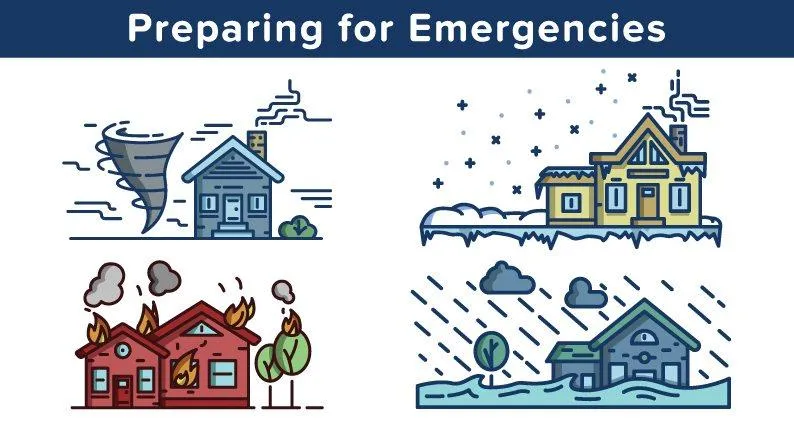
Natural Disaster Preparedness: Safeguarding Your Landscape Natural disasters are unpredictable, and they can wreak havoc on homes and landscapes in an instant.
While most people focus on securing their homes and properties, preparing your landscape for natural disasters is equally important. Proactive landscaping can minimize damage, protect your home, and ensure faster recovery when disaster strikes. At Graceful Landscapes, we specialize in not only creating beautiful outdoor spaces but also ensuring they are resilient and built to withstand the challenges nature may bring. Here’s how you can prepare your landscape for different types of natural disasters.
1. Floods and Heavy Rainfall Flooding can devastate your garden, soil, and plants if not properly managed. Here’s how to prepare: • Install Proper Drainage Systems: Ensure your property has adequate drainage to prevent water from pooling in your yard. Consider installing French drains, rain gardens, or dry creek beds to channel water away from your home and garden. • Choose Flood-Resistant Plants: Opt for plants that are better suited for soggy conditions, such as certain ornamental grasses and native perennials. These plants can help absorb excess water and minimize erosion. • Mulch to Prevent Erosion: Mulching your garden beds with organic materials helps reduce soil erosion and retains moisture during dry spells. It also prevents the soil from being washed away during heavy rains.
2. Hurricanes and High Winds Strong winds can uproot trees, damage structures, and scatter debris. To protect your landscape: • Prune Trees and Shrubs: Regular pruning removes weak branches that are more likely to break off in high winds. Keep trees healthy and structurally sound to reduce the risk of falling branches. • Remove High-Risk Trees and Debris: Dead or diseased trees are particularly vulnerable to high winds, making them a hazard to your home and surrounding area. Removing these high-risk trees before hurricane season can prevent serious damage. Also, clear out debris like fallen branches, leaves, and other clutter that could be picked up by winds and cause further harm. • Select Wind-Resistant Trees: When choosing trees, opt for species that have deep roots and strong wood, such as oaks or hollies, which are more resistant to wind damage. • Secure Outdoor Furniture and Decorations: High winds can turn outdoor furniture, garden ornaments, and potted plants into projectiles. Anchor down or store items before a storm hits.
3. Droughts and Wildfires In areas prone to droughts and wildfires, thoughtful landscaping can be a key defense: • Install Drought-Resistant Plants: Native plants are often better adapted to survive periods of drought. Succulents, ornamental grasses, and Mediterranean-style plants are water-efficient and thrive in dry conditions. • Create Defensible Space: Maintain a defensible space around your home by keeping plants and trees well-trimmed, especially near your house. Removing dead trees, limbs, and dry brush helps prevent wildfires from spreading to your property. • Install Smart Irrigation Systems: A well-designed irrigation system conserves water during droughts while keeping your plants hydrated. Consider drip irrigation for efficient water use.
4. Earthquakes While landscaping may not prevent earthquake damage, you can take steps to minimize risks: • Secure Hardscaping Features: Retaining walls, stone walkways, and other hardscaping features should be built to withstand ground movement. Properly reinforced structures are less likely to collapse or shift during an earthquake. • Avoid Large Rock or Boulders Near the Home: If you live in an earthquake-prone area, avoid placing large rocks or boulders too close to your home, as they can become hazards if dislodged.
5. Winter Storms and Frost Cold weather can damage delicate plants and disrupt landscapes: • Cover Sensitive Plants: Use frost cloths or blankets to cover sensitive plants before freezing temperatures arrive. Mulching around the base of plants can also help insulate the roots. • Protect Pipes and Irrigation Systems: Drain your irrigation system before the first frost to prevent pipes from freezing and bursting. Wrap any exposed pipes with insulation to protect them from freezing temperatures.
Be Prepared with Graceful Landscapes At Graceful Landscapes, we understand that nature can be both beautiful and unpredictable. Our expert team can help you design and maintain a landscape that not only enhances the beauty of your property but also protects it from natural disasters. From the strategic removal of high-risk trees and debris to advanced drainage solutions, we are here to ensure that your outdoor space is as resilient as it is stunning. Contact us today for a consultation on how we can fortify your landscape against the elements and keep your property safe, no matter what nature throws your way. Ready to protect your landscape?
Get in touch with Graceful Landscapes to discuss how we can prepare your outdoor space for any natural disaster.